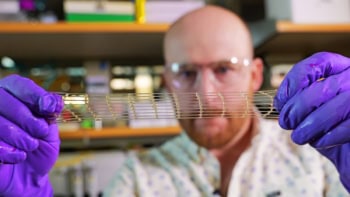
A strong, flexible and tough hydrogel that contains more than 70% water could be used to make durable artificial tendons and other load-bearing biological tissues. The new hydrogel was made by researchers at the University of California, Los Angeles, US and is based on polyvinyl alcohol (PVA) – a material that is already approved for some biomedical applications by the US Food and Drug Administration.
Biological tendons are also more than 70% water, yet they remain strong and tough thanks to a series of connecting hierarchical structures that span length scales from nanometres to millimetres. Researchers have been trying to mimic these materials using hydrogels, which are three-dimensional polymer networks that can hold a large amount of water and are structurally similar to biological tissue. The problem is that so far, hydrogels that contain as much water as natural tendons tend not to be as strong, tough or resistant to fatigue as their biological counterparts.
Salting out a freeze-casted structure
In their work, a team led by Ximin He of UCLA’s Samueli School of Engineering began by freeze-casting, or solidifying, PVA to create a honeycomb-like porous polymer structure. The micron-sized walls of the pores in this material are aligned with respect to each other and serve to increase the concentration of PVA in localized areas.
The researchers then immersed the polymer in a salt solution (“salting out”) to precipitate out and crystallize chains of the polymer into strong threads, or fibrils, that formed on the surface of the pore walls. This phenomenon is known as the Hofmeister effect.
Hierarchical assembly of anisotropic structures
The resulting hydrogels have a water content between 70 and 95%. Like natural tendons, they contain a hierarchical assembly of anisotropic structures spanning lengths from the molecular scale up to a few millimetres.
He and colleagues tested various salt ions in their experiments and found that sodium citrate was the best at salting out PVA. When they used a mechanical tester to measure the stress-strain characteristics of the resulting hydrogel, they found that it had an ultimate stress of 23.5 ± 2.7 megapascals, strain levels of 2900 ± 450 %, a toughness of 210 ± 13 megajoules per cubic metre, a fracture energy of 170 ± 8 kilojoules per square metre and a fatigue threshold of 10.5 ± 1.3 kilojoules per square metre. The researchers say that these mechanical properties resemble those of natural tendons. They also note that their hydrogel showed no signs of deterioration after 30 000 stretch cycles.
Replicating other soft tissue
Since the Hofmeister effect exists for various polymers and solvent systems, He says the technique used in this work, which is detailed in Nature, could apply to other materials too. It might therefore be possible to use hydrogel-based structures to replicate other soft tissues in the human body, not just tendons.

Conductive hydrogel could repair damaged peripheral nerves
As well as making these other tissues, the hydrogels could be used in bioelectronics devices that have to operate over many cycles, adds He. The structures could also be used as a coating for implantable or wearable medical devices to improve their fit, comfort and long-term performance.
The researchers’ longer-term ambition is to use the new hydrogel to mimic not only load-bearing tissues but also functional organs. “This could be achieved by combining 3D printing and tissue engineering with the hydrogel we have developed,” study lead author Mutian Hua tells Physics World.



